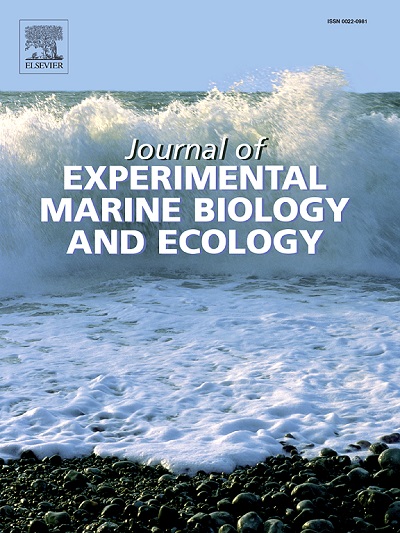Crevices increase feeding behavior, crawling behavior and glucose level of stressed sea cucumbers (Apostichopus japonicus)
IF 1.8
3区 生物学
Q3 ECOLOGY
Journal of Experimental Marine Biology and Ecology
Pub Date : 2025-02-01
DOI:10.1016/j.jembe.2025.152088
引用次数: 0
Abstract
Sea cucumbers seek refuge to crevices in adverse environments. However, the mechanism by which crevices mitigate the adverse impacts of stress on sea cucumbers remains totally unknown. The present study investigated the detrimental effects of mechanical perturbation on behavior and physiology of sea cucumbers (Apostichopus japonicus). We subjected sea cucumbers to mechanical perturbation by placing them in a sieve submerged in water and stirring the sieve parallel to the water surface to simulate common mechanical perturbation in seed production. We found that mechanical perturbation significantly reduced cortisol, glucose, crawling frequency, and feeding duration of A. japonicus. These results suggest that mechanical perturbation decreases cortisol and glucose levels, potentially impacting feeding and crawling behaviors of A. japonicus.
This study further investigated how crevices mitigated the negative effects of mechanical perturbation. There was a significant increase in the residence time of A. japonicus within crevices, while A. japonicus without crevices exhibited significantly increased movement distances after mechanical perturbation. These results indicate a preference among A. japonicus for inhabiting crevices or actively seeking such habitats following mechanical perturbation. Following mechanical perturbation, A. japonicus exhibited a significantly decrease in feeding time and crawling frequency compared to those that had been inhabiting crevices for 7 h. Sea cucumbers in the crevice showed a significantly higher crawling frequency after being exposed to 7 h of mechanical perturbation, compared to the individuals not in the crevice. These results indicate that crevices serve as an efficacious mechanism for ameliorating the negative impacts of mechanical perturbation on sea cucumber behaviors. Further, the glucose level increased significantly with the increase of time in the crevice in sea cucumbers subjected to mechanical perturbation.
In summary, crevices attenuate the deleterious impacts of mechanical perturbation on sea cucumbers by enhancing glucose level, crawling, and feeding behaviors, thereby probably promoting the production efficiency in aquaculture of A. japonicus. The study elucidates the mechanism by which crevices alleviate stress in A. japonicus, providing valuable insights into the seed production.
裂缝增加应激海参的摄食行为、爬行行为和葡萄糖水平
在恶劣的环境中,海参会躲到缝隙里。然而,裂缝减轻压力对海参不利影响的机制仍是完全未知的。研究了机械扰动对海参(Apostichopus japonicus)行为和生理的不利影响。我们将海参置于浸入水中的筛子中,并平行于水面搅拌筛子,以模拟制种过程中常见的机械扰动,从而对海参进行机械扰动。我们发现,机械扰动显著降低了日本刺参的皮质醇、葡萄糖、爬行频率和摄食时间。这些结果表明,机械扰动降低了皮质醇和葡萄糖水平,可能影响日本刺参的摄食和爬行行为。本研究进一步探讨了裂缝如何减轻机械扰动的负面影响。裂缝内的日本刺参停留时间显著增加,而无裂缝的日本刺参在机械扰动后的移动距离显著增加。这些结果表明,在机械扰动下,日本刺参倾向于居住在裂缝中或积极寻找这种栖息地。机械扰动7 h后,日本刺参的取食时间和爬行频率显著低于在裂缝中居住7 h的刺参,而在裂缝中的海参在机械扰动7 h后,其爬行频率显著高于不在裂缝中的海参。这些结果表明,裂缝是一种有效的机制,可以改善机械扰动对海参行为的负面影响。此外,受机械扰动的海参中葡萄糖水平随着时间的增加而显著增加。综上所述,裂缝通过提高葡萄糖水平、爬行和摄食行为来减弱机械扰动对海参的有害影响,从而可能提高日本刺参的养殖生产效率。该研究阐明了裂缝缓解胁迫的机制,为种子生产提供了有价值的见解。
本文章由计算机程序翻译,如有差异,请以英文原文为准。
求助全文
约1分钟内获得全文
求助全文
来源期刊
CiteScore
4.30
自引率
0.00%
发文量
98
审稿时长
14 weeks
期刊介绍:
The Journal of Experimental Marine Biology and Ecology provides a forum for experimental ecological research on marine organisms in relation to their environment. Topic areas include studies that focus on biochemistry, physiology, behavior, genetics, and ecological theory. The main emphasis of the Journal lies in hypothesis driven experimental work, both from the laboratory and the field. Natural experiments or descriptive studies that elucidate fundamental ecological processes are welcome. Submissions should have a broad ecological framework beyond the specific study organism or geographic region.
Short communications that highlight emerging issues and exciting discoveries within five printed pages will receive a rapid turnaround. Papers describing important new analytical, computational, experimental and theoretical techniques and methods are encouraged and will be highlighted as Methodological Advances. We welcome proposals for Review Papers synthesizing a specific field within marine ecology. Finally, the journal aims to publish Special Issues at regular intervals synthesizing a particular field of marine science. All printed papers undergo a peer review process before being accepted and will receive a first decision within three months.

 求助内容:
求助内容: 应助结果提醒方式:
应助结果提醒方式:


